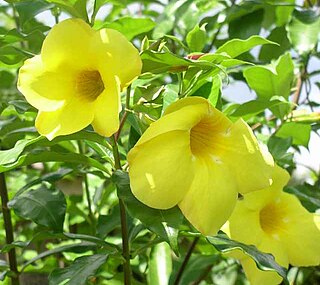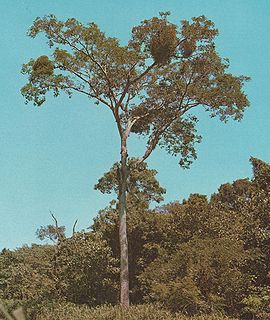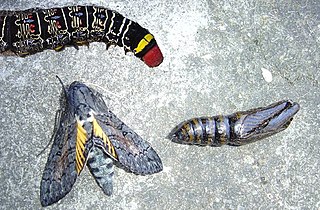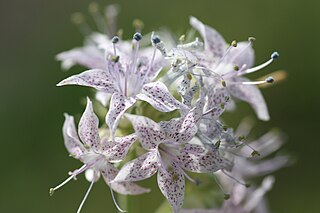
Apocynaceae is a family of flowering plants that includes trees, shrubs, herbs, stem succulents, and vines, commonly known as the dogbane family, because some taxa were used as dog poison. Members of the family are native to the European, Asian, African, Australian, and American tropics or subtropics, with some temperate members. The former family Asclepiadaceae is considered a subfamily of Apocynaceae and contains 348 genera. A list of Apocynaceae genera may be found here.

Allamanda is a genus of flowering plants in the family Apocynaceae. They are native to the Americas, where they are distributed from Mexico to Argentina. Some species are familiar as ornamental plants cultivated for their large, colorful flowers. Most species produce yellow flowers; A. blanchetii bears pink. The genus name Allamanda honors the Swiss botanist and physician Frédéric-Louis Allamand (1736–1809). It also is official flower of Kuching North City Hall.

Rosa multiflora is a species of rose known commonly as multiflora rose, baby rose, Japanese rose, many-flowered rose, seven-sisters rose, Eijitsu rose and rambler rose. It is native to eastern Asia, in China, Japan and Korea. It should not be confused with Rosa rugosa, which is also known as "Japanese rose", or with polyantha roses which are garden cultivars derived from hybrids of R. multiflora. It was introduced to North America, where it is regarded as an invasive species.

Allamanda cathartica, commonly called golden trumpet, common trumpetvine, and yellow allamanda, is a species of flowering plant of the genus Allamanda in the family Apocynaceae. It is native to Brazil. This plant is cited in Flora Brasiliensis by Carl Friedrich Philipp von Martius.

Erinnyis alope, the Alope sphinx, is a moth of the family Sphingidae. It lives from the northern part of South America, through Central America, up to Northern Mexico and the very south of the United States, although strays have been recorded as far north as Arkansas and Kansas.
Michael Williams is an American author. He is known for his Dragonlance novels.

Allamanda blanchetii is a species of perennial flowering plant in the family Apocynaceae native to Brazil. Cultivated as an ornamental plant, it grows in full sun in USDA Zones 9b through 11 including central and south Florida, southernmost Texas, and coastal California. This plant's purple, bell-shaped blooms are about 3" across. It is also called red bell.

Allamanda schottii, commonly known as bush allamanda, is a shrub of genus Allamanda in the family Apocynaceae, which is native to Brazil. Reaching 2.5 metres (8.2 ft) in height, it bears large yellow flowers for much of the year. Grown as an ornamental plant, it has become a weed in several countries.
Allamanda puberula is a species of plant in the family Apocynaceae, which is native to Brazil, typically in Caatinga, and Cerrado vegetation. This plant is cited in Flora Brasiliensis by Carl Friedrich Philipp von Martius.

Allamanda angustifolia is a species of plant in the genus Allamanda in the family Apocynaceae, which is found in Brazil, typically in Cerrado vegetation. This plant is cited in Flora Brasiliensis by Carl Friedrich Philipp von Martius. Known in English as alamander, it has been widely cultivated and naturalized in Florida and elsewhere in the United States.

Albizia inundata is a perennial tree native to South America. Common names include maloxo, muqum, paloflojo, timbo blanco, timbo-ata, and also "canafistula" though this usually refers Cassia fistula.

Pseudoscolopia is a genus of plants in the family Salicaceae, which contains a single species, Pseudoscolopia polyantha. It is endemic to South Africa. It is threatened by habitat loss.
Tillandsia polyantha is a species of plant in the family Bromeliaceae. It is endemic to Ecuador. Its natural habitats are subtropical or tropical moist montane forests and subtropical or tropical high-altitude shrubland. It is threatened by habitat loss.

Floribunda is a modern group of garden roses that was developed by crossing hybrid teas with polyantha roses, the latter being derived from crosses between Rosa chinensis and Rosa multiflora. The idea was to create roses that bloomed with the polyantha profusion, but with hybrid tea floral beauty and colour range.

Isognathus allamandae is a moth of the family Sphingidae. It is found from Brazil to Venezuela.

Isognathus caricae is a moth of the family Sphingidae. It is known from Costa Rica, French Guiana, Bolivia, Argentina and Brazil.

Isognathus leachii is a moth of the family Sphingidae.
Cyrtandra polyantha is a rare species of flowering plant in the African violet family known by the common names Niu Valley cyrtandra. It is endemic to the Hawaii, where it is known only from the Koʻolau Mountains of Oahu. In 2007 there were only two populations containing a total of 46 mature plants, but one of the two populations is made up of a single individual. It was federally listed as an endangered species in 1994. Like other Hawaiian Cyrtandra it is called ha`iwale.

Ipomopsis polyantha is a rare species of flowering plant in the phlox family known by the common names Pagosa ipomopsis, Pagosa skyrocket and Archuleta County standing-cypress. It is endemic to Colorado in the United States, where it occurs only in the vicinity of Pagosa Springs in Archuleta County. It is threatened by the loss of its habitat to residential and commercial development. It was federally listed as an endangered species in 2011.
Wikstroemia polyantha grows as a small tree up to 7 metres (20 ft) tall, with a stem diameter of up to 8 centimetres (3 in). The twigs are reddish to dark brown. Inflorescences bear at least six flowers which are yellow, yellowish green or white. Fruits are red. The specific epithet polyantha is from the Greek meaning "many flowers". Habitat is forests from sea-level to 2,200 metres (7,000 ft) altitude. W. polyantha is found in Malaysia, Indonesia and the Philippines.













